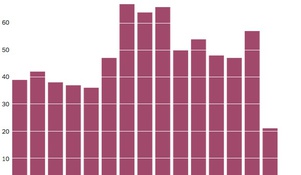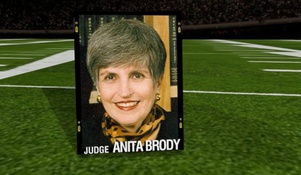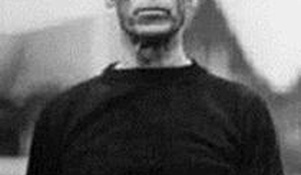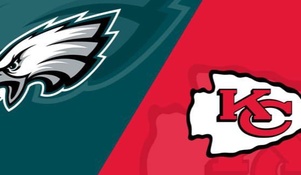NFLPA TIP: Don't quote union-busters

In a recent NFL Players Association newsletter - in their “NFLPA Tips” - the union quoted Ben Franklin, a man who owned slaves for 40 years and profited from their hard work and labor. I wrote about their poor choice of qoutes in my article entitled “NFL Players Association: Consider the Source!”
Now, in their most recent newsletter - in their “NFLPA Tips” - they decide to use a quote from Andrew Carnegie: "As I grow older, I pay less attention to what men say, I just watch what they do."
Andrew Carnegie became one of the wealthiest men in the world through the steel empire he created. By 1890 he was earning nearly $25 million annually, which is equivalent to $658 million annually in today’s dollars.
So, how did he create that wealth? It was simple; he did it off the backs of his workers who were making an average of $10 a week, or $500 annually.
Let's not pay any attention to what Andrew Carnegie said……let’s just watch what he did.
Carnegie opposed the unionization of the workers in his steel plants, believing that unions interfered with good company management. In 1892, the workers at his Homestead Pennsylvania steel mill went on strike for better wages.
Carnegie was determined to break the hold of the Amalgamated Association of Iron and Steel Workers Union, so he partnered with Henry Clay Frick, a ruthless coal mining businessman. Frick hired guards from the Pinkerton Detective Agency, who had a reputation as strike-busters, and the Homestead picket line erupted into violence. Three workers and seven Pinkerton agents died, and many more were left injured. The incident captured national attention, and the Pennsylvania governor sent in the state militia to maintain order. The Homestead workers remained locked out, however, and no other union attempted to organize at a Carnegie plant until the 1930s. Here’s a great PBS article about this incident and an excerpt from the article:
In mid-November, the union conceded. Three hundred locked-out men applied for work and were rehired. Many more were blacklisted. Carnegie cabled Frick. "First happy morning since July." With the union crushed, Carnegie slashed wages, imposed twelve-hour workdays, and eliminated 500 jobs. "Oh that Homestead blunder," Carnegie wrote a friend. "But it's fading as all events do & we are at work selling steel one pound for a half penny."
That strike may have faded from most people’s minds, but we can’t forget the past and when the NFLPA starts quoting a union-buster, they are, in effect, disrespecting all former players that went on strike to get better wages and pensions.
A picture is worth a thousand words, so instead of paying attention to what former players said............here’s a look at what they did.
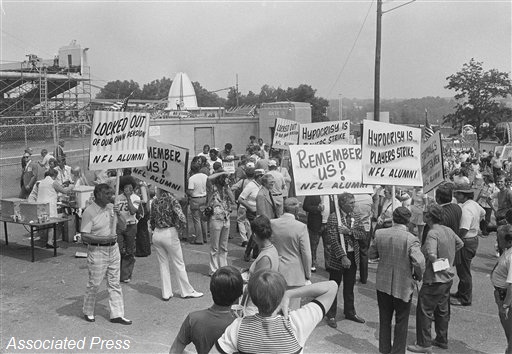
Canton's Fawcett Stadium where striking NFL players set up picket lines prior to Saturday's Hall of Fame game in Canton, Ohio, July 29, 1974.

Vikings defensive tackle Alan Page, NFLPA president Bill Curry and Oilers quarterback Dan Pastorini were among the 1974 striking players. The NFLPA slogan was - “No Freedom – No Football”

Despite the failure of the 1974 strike, Roy Jefferson (right), then Washington's player rep, believes the groundwork was laid for the massive contracts of today. He was right!

The 1987 Player Strike: Check out the sign “On Strike for Fair Player Contracts and Better Pensions for All Players 1920 Through 1990. We must keep pushing for that second item!

Even the fans were with the players. We can't forget how the NFL used scab players to break the strike.
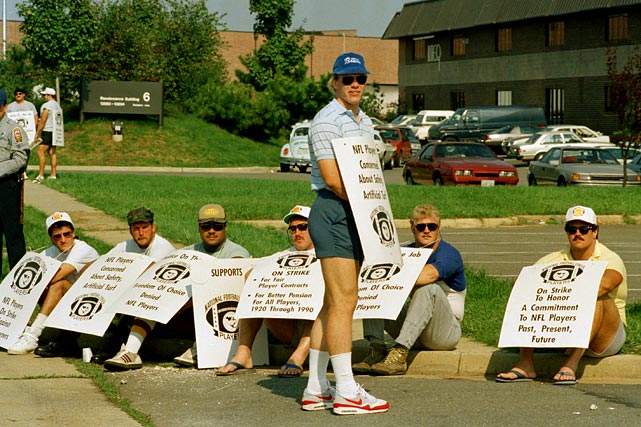
Quarterback Jay Schroeder stands in front of fellow Redskins teammates as they picket near the team's facility in Sept. 1987. No Redskins crossed the picket line during the 1987 strike!

The news article reads: Confronting Scabs is a vital function in holding the union's picket line. That's defensive tackle Kevin Brooks of the Cowboys taunting replacement players as they leave their Dallas training ground.

Giants players walk the picket line at the Meadowlands during the 1987 NFL players' strike.
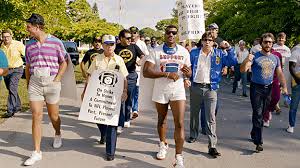
Miami Dolphins quarterback Dan Marino, left, in striped shirt, and striking Dolphins and supporters walk past police at the Dolphins' training camp on Sept. 25, 1987.

A Fairfax County police officer holds back Washington Redskins players R.C. Thielemann, glasses, left, and Darryl Grant, right, as a busload of newly recruited players arrives Sept. 23, 1987, at the Redskins Park practice facility in Chantilly, Va.
In closing, I would be remiss if I didn’t point out that the strike of 1982 was the longest “in-season” work stoppage in the history of the NFL. It lasted 57 days and forced the cancellation of 7 regular season games. The Players Association also conducted a 136-day lockout, during the NFL’s “off-season” that went from March 12 - July 25, 2011.
I hope the current players understand that these actions laid the foundation for better working conditions, better wages and better benefits for future players. Former players may not have won all the battles along the way, but each battle made the Union stronger and wiser and players eventually won the war for free agency and a larger piece of the revenues.
During the NFL player lockout of 2010 the NFLPA said "If it wasn't for players, namely John Gordy, players wouldn't have any benefits." John Gordy, was a former Detroit Lions offensive lineman who helped form the Players Association and negotiated the very first collective bargaining agreement. John Gordy died in 2009, but he will always be remembered for conducting the very first strike against the NFL. On July 3, 1968, after talks with the owners stalled, the NFLPA voted to strike. The owners countered by declaring a lockout, but on July 14, the owners relented and the brief strike was over.
The NFLPA should be quoting guys like John Gordy…………not Andrew Carnegie.
In the final analysis, it really is all about what you do………not what you say.

